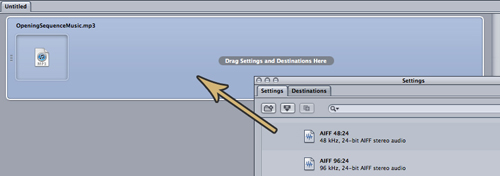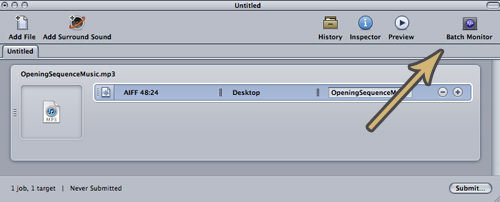AIFF, MP3 and WAVs — What’s the Best Audio Format for Video Editing in Final Cut Pro?
In this post, we’ll tackle a question commonly asked by video editors — what audio file format is best for use in my Final Cut Pro video editing software?
First, let’s get this out of the way:
- Final Cut Pro hates MP3.
- This goes for the new Final Cut Pro X, as well as legacy versions of the application.
- Attempting to use MP3s in your FCP projects will cause problems.
MP3s by their very nature are a highly compressed format. When placed on a Final Cut Pro timeline you may run into some of the following problems:
- Click and Pops (common offenders)
- Diminished sound quality
- MP3 will require rendering (no matter the sequence settings)
- Once rendered, the application may “lose track” of the audio — drifting sync, starting and stopping at odd points and not matching up to the audio waveform
The most obvious fix to this problem is to use a higher-quality audio file format if avaliable. Most stock music sites (such as Premiumbeat) will provide their music and sound effects as either WAVs or AIFFs…both formats that “play well” with Final Cut Pro. Mixes from audio post facilities, as well as audio files from digiatal field recorders, are often recorded as WAVs. Some Mac applications will save high quality audio files as AIFFs. So, now you might be scratching your head…”So MP3s are bad for FCP, but what’s the difference between WAVs and AIFFs?”
AIFFs and WAVs are essentially the same file type…both use the same PCM compression (for the technical low down on PCM, wrap your head around this). Intially, the AIFF wrapper was developed to work best on Mac systems, while WAVs were designed for PC. Today, it makes litte difference as they work well on either.
So, let’s say that your client hands you some voice-over that was recorded to MP3. They long ago trashed any high-resolution versions of that audio. Now you’re tasked with integrating the audio into a project. Don’t panic, here’s the drill:
As we said before, MP3s are highly compressed. There’s not going to be much you can do about that. You can’t decompress a file, magically turning a low resolution piece of audio into a stunning high resolution one. You only have the audio “information” that was included in the compressed MP3 file, and well, you’re just going to have to work with that.
That being said, you can convert the MP3 file into a WAV or AIFF so that it will integrate better within Final Cut Pro. Let’s take a look at 2 ways to convert an MP3. Note, the converted file will have the same quality as an MP3, but wrapped as an AIFF or WAV.
Convert MP3 to AIFF using Compressor
Users of previous versions of Final Cut Pro will find Compressor included in the Final Cut Studio suite. With the release of FCPX, Compressor is avaliable as a standalone application from the App Store. Compressor makes converting your MP3s to AIFFs a breeze.
- Drag the MP3 into the main Compressor window (or click on the “Add File” button).

- The Settings window: If it not visible in your Compressor layout use the shortcut COMMAND + 3 to bring it up. Navigate to the Audio Formats folder.

- In Compressor 4: Drag the AIFF setting onto your MP3.

- In earlier versions of Compressor: Drag the AIFF 48:24 setting onto your MP3.

- In the main Compressor window right click on “Source” and choose the Destination you would like to save the AIFF file.

- Click “Submit”

- Clicking “Batch Monitor” will show the progress of the conversion.








Note: You can drag multiple MP3s into the Compressor window and apply the settings. Then batch convert them all at once.
Convert MP3 to AIFF using MPEG Steamclip
We’ve sung the praises of the free application MPEG Streamclip before…and here we go again! On the long list of formats and codecs it can encode/transcode, add audio…and more specifically MP3 to AIFF.
- From the menu bar in MPEG Streamclip choose File > Open Files
- Make sure “Audio Files” is enabled from the dropdown and navigate to the MP3 you’d like to convert.

- Streamclip may return an “Unsupported File Type” message, but choose “Open Anyways”

- You should now be able to playback your MP3 in the application.
- From the menu bar choose File > Export Audio. In the pop-up window choose 48khz (a digital video standard). Click “OK”

- Choose the destination for your converted file and click “Save”.



Just as a legal disclaimer, we never recommend converting copyrighted music or using such music in your video projects without permission of the owner/creator. For the whole shebang on music and copyright check out our previous article here.
Ultimately, the best sceneario is having a WAV or AIFF as the original file. If you’re looking for high-quality, royalty free WAVs check out our selection here at Premiumbeat. However, when you’re only given an MP3 to work with, convert it!
What software applications do you use for conversions?
We want to hear from you in the comments!





